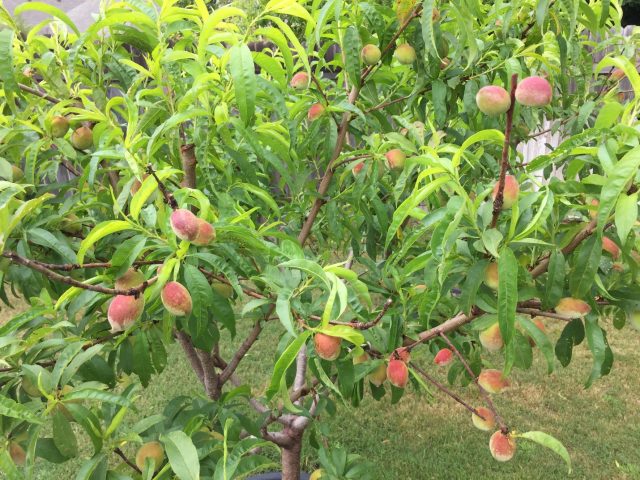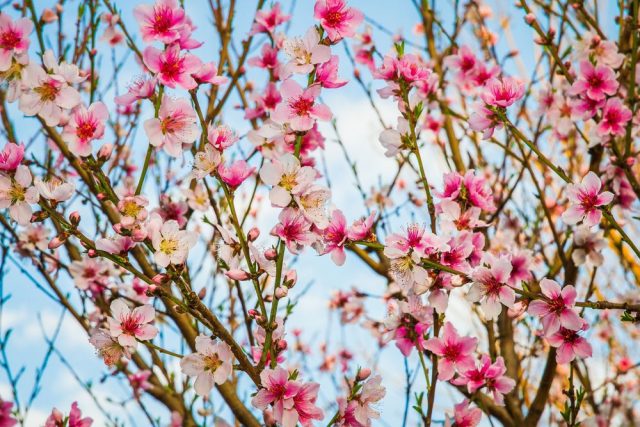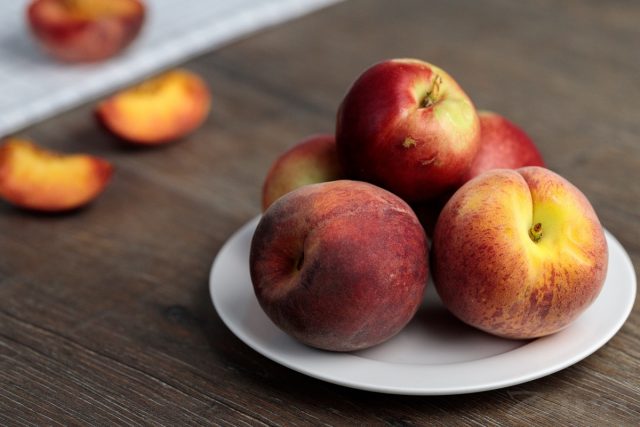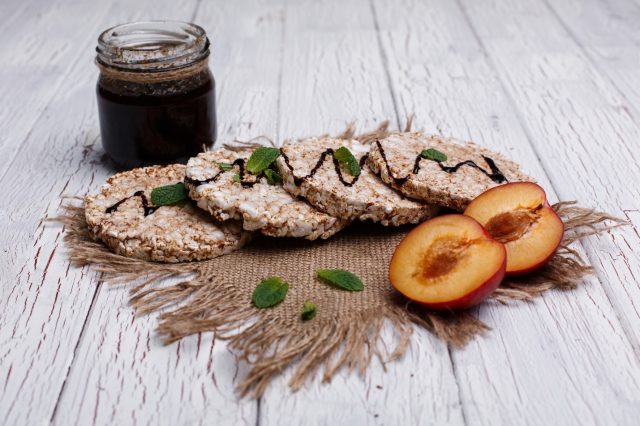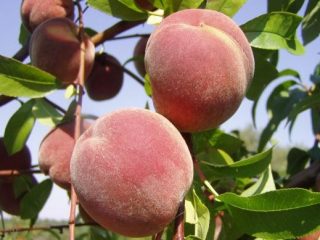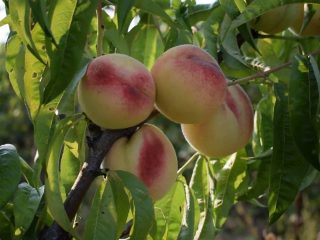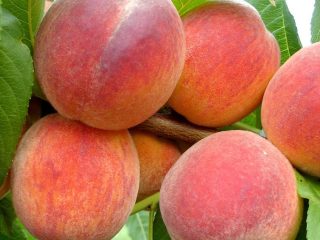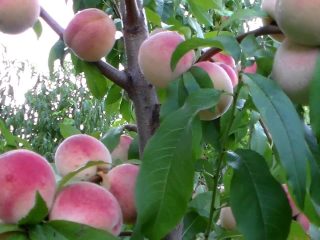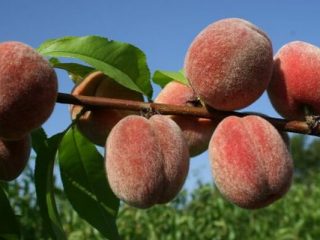Content
Peach is a tree that is known primarily for its delicious fruits: they are widely used in cooking in the preparation of a wide variety of delicious dishes. The culture is characterized by unpretentious care, but does not tolerate low temperatures. About what features a peach has, a photo of a tree and its varieties, about growing conditions, as well as advice on the collection and use of unripe fruits - described in detail in the article.
What does a peach look like
China is considered the birthplace of the plant. It is a perennial tree belonging to the Plum genus, the Pink family. In suburban areas, mainly garden varieties are grown, originating from the common peach (Persica vulgaris).
What a peach tree
Peach is a deciduous, upright, fruit tree with a lush, dense crown about 6 m in diameter. The height of the plant directly depends on the variety. As a rule, it is 3-4 m. Some specimens can grow up to 9 m.
The plant belongs to the subgenus of Almond, and, as you can see from the photo, the peach tree is really very similar to the almond.
The trunk of the tree is covered with brownish-red scaly bark. Old branches are thick, powerful, rough to the touch, young ones are smooth and thin. The roots are close to the surface of the earth, at a depth of about 30-50 cm. The leaves are bright green, lanceolate, with small teeth. There is no pubescence on the leaf blade.
Fruits can be various in shape: round, elongated-round, flattened or ovoid. One side is divided by a groove. The peel is thin, from white-green to deep yellow, with reddish-orange tints. The pulp of white and red shades, juicy, with a pronounced aroma, sweet and sour taste. Inside there is a dense, ribbed, brown seed with a seed.
Fruit diameter - 6 - 12 cm.The weight, depending on the variety, ranges from 60 to 200 g.
According to biological characteristics, two types of fruits are distinguished:
- peaches, characterized by soft peeling;
- nectarines, the skin of which, like a plum, is bare.
How peaches grow
Peach is considered a southern culture. The tree loves bright light and absolutely does not tolerate cold. When the temperature drops to -17 oC, part of the branches and roots freezes and dies. Severe frosts can provoke the complete death of the plant.
You can plant a crop in any soil, but it does not tolerate saline and waterlogged soil well. In the absence of enough air, the root system begins to die off.
An elevated, well-lit area on the south side, which should also be protected from the wind, is perfect for landing.
You should not plant the tree too close to other plants and tall buildings, as they will block it from the sun. The optimum distance is at least 3 m.
How the peach blooms
Peach flowers are actinomorphic in shape, goblet. The diameter does not exceed 5 mm; mostly single, but sometimes you can find paired; consist of 5 petals.
How the peach blooms can be seen in the photo.
Flowers of pink, red and white shades, sessile or collected in small bouquets, bloom before the leaves. There are decorative varieties with striped and double flowers.
The duration of peach flowering is 2 weeks, however, with severe drought and heat, this time is reduced to 2 - 3 days.
Peach yield
Peaches are characterized by high yields. Depending on the variety, 30 to 60 kg of fruits are harvested from one tree under optimal growing conditions.
Variety | Yield (kg) |
Beloved | 50 — 60 |
Ambassador of Peace | 30 — 40 |
Gift from Kiev | 30 — 50 |
Slavutich | 30 — 50 |
Redhaven | 30 — 40 |
Nectarine Kievsky | 20 — 30 |
Generous 53M | 30 — 50 |
Oksamytovy | 30 — 50 |
Forest-steppe | 30 — 50 |
Donetsk Yellow | 50 — 60 |
How many years does a peach bear fruit
Young peaches begin to bear fruit in the 2nd - 3rd year after planting. Fruiting time depends on soil, care and climate. In favorable conditions, the harvest has been actively formed for 20 years. Subsequently, the tree, as a rule, begins to age, but there are cases when the appearance of fruits did not end even at the age of thirty.
Where do peaches grow in Russia
Peach trees are actively cultivated in the south in regions with warm winters: in the Krasnodar Territory, Dagestan, Crimea and the Caucasus.
For the cultivation of this crop, those regions are suitable in which from June to September the air temperature does not drop below +24 oC. And in the winter period - below -10 oC. At a temperature of -25 oC the tree dies.
However, gardeners also grow peaches in the Moscow region. In this case, the beginning of spring is the optimal time for planting. Pruning the plant to a shrub shape allows for a higher yield.
Peaches growing in central Russia must be covered for the winter with foam or expanded polystyrene air structures.
For growing peaches in the Moscow region, Moscow and Central Russia, varieties with high winter hardiness are suitable:
- Kiev Early;
- Red-cheeked;
- Cardinal;
- Redhaven;
- Collins;
- Kremlin.
What are the most delicious peaches
When choosing a variety for planting, it is also important to build on the desired taste. Below are the 5 most delicious, according to professional gardeners, varieties.
Collins
It is an early ripe variety with large yellow-red fruits. Their average weight reaches 150 g. The flesh tastes sweet, with a slight sourness.
Collins is renowned for its yield. Therefore, so that the branches do not break under the weight of massive fruits, it is important to remove ripe fruits in time.
The culture calmly tolerates frosts, is immune to powdery mildew and curliness. Needs regular feeding, abundant watering and pruning of the crown.
Kiev early
An early variety, often grown by summer residents in the Crimea and other regions with a warm spring climate. Yields very juicy, tasty yellow-pink fruits weighing 80 - 100 g.
Plants have high yields, are resistant to clasterosporosis and powdery mildew. They do not tolerate excessive moisture or dryness of the soil.
Redhaven
Redhaven is another early ripening variety that adapts to changing climatic conditions. Perfect for both private and industrial breeding.
The fruits are large, weighing 150 - 170 g. The color is closer to orange-golden, there are red blotches on the skin. The pulp is yellow, delicate in taste, with a pronounced odor.
The variety is resistant to frost and curl, but with improper care it is susceptible to fungal attack. To avoid such problems, it is important to carry out feeding and disease prevention on time.
Cardinal
Cardinal peaches of medium size, weighing 100 - 150 g, slightly flattened on the sides. The skin is yellow with a carmine blush. Fragrant pulp.The fruits have high taste and have a score of 5 points on the main tasting scale.
This variety does not tolerate frost well and needs special care. It is resistant to powdery mildew.
Kremlin
A popular variety that adapts well to any conditions. The fruits themselves are orange-yellow with ruddy red blotches, weighing up to 200 g. They have a unique sweet taste, delicate aroma.
Kremlin peaches are immune to most diseases, are characterized by high winter hardiness, which allows them to be grown in regions with a cool climate. The tree does not like waterlogging of the soil, so it is important to carefully control watering. Landing in elevated areas is recommended.
When does the peach season begin in Russia
The ripening season for early varieties of peaches in Crimea begins in mid-June. In the middle lane, the peach season begins in August or September.
Can peaches be removed unripe
Fruit can be removed from the branches and unripe, in this form they are more rigid. This is especially true if in the future they need to be transported: soft, ripe fruits can be damaged during transportation. If damaged, the product will deteriorate in 2 - 3 days.
If transportation is planned under refrigerated conditions, it is recommended to remove the fruits no later than 5 days before full ripening.
The disadvantage of early harvesting is the wrinkling of the skin of the fruit.
How to make peaches ripen at home
Unripe fruits can easily ripen at home. There are several ways to do this:
- Unripe peaches should be spread out on flat plates or trays and left for 3 to 5 days at room temperature.
- Place them in a paper bag along with an apple or banana. Leave to ripen at room temperature for a day. Check and extend the time if necessary.
- For more juicy fruits, you need to wrap the peaches in a linen napkin. Ripening in this way will take several days.
What can be made from unripe peaches
Unripe fruits can be used immediately. Very tasty peach jam is prepared from them for the winter. They are also used to make compotes and jams.
Unripe peaches are also used in the preparation of second courses. Together with them, you can bake chicken, duck, pork, make pizza, fish soup or pilaf. In baking, they are used as a filling for various desserts and pies.
How to store peaches
Only firm, undamaged fruits can be stored for a long time. Ideal temperature - 0 oC. It corresponds to the temperature in the refrigerator in the vegetable compartment. A cellar or basement will also work. In such conditions, peaches can be stored for a whole month.
The higher the temperature, the less time the fruit will stay fresh. Fruit can be kept at room temperature for up to 5 days.
Conclusion
An amazing tree is a peach, a photo of its flowering and fruits only confirms this once again. There are few plants that can match it in beauty and taste of fruit. It is not for nothing that since ancient times, comparison with a peach was considered the highest praise for girls.
